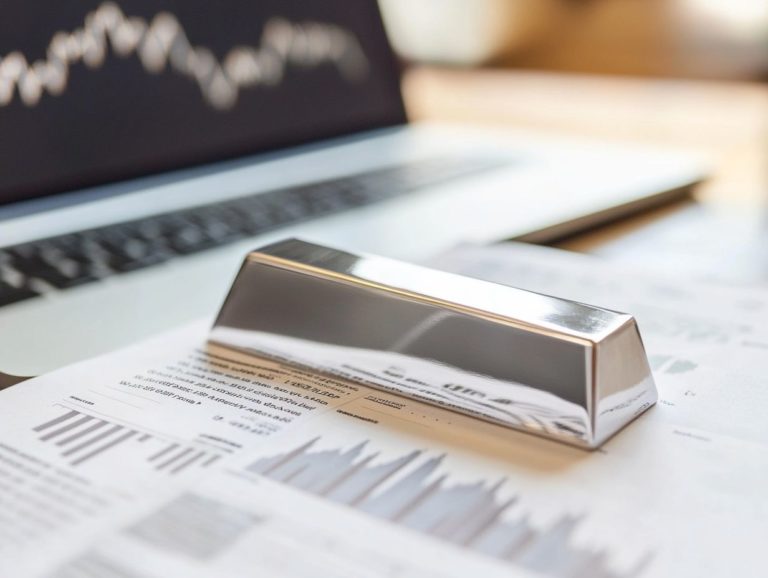The Impact of World Events on Platinum
Platinum, while frequently eclipsed by gold and silver, holds significant importance across various sectors, particularly in automotive and jewelry. To truly grasp its value, you need to delve into current market trends and examine the factors that affect prices, including supply and demand, geopolitical events, and economic shifts.
Historical events, such as the Global Financial Crisis and the COVID-19 Pandemic, have profoundly influenced platinum’s market landscape. Let s dive into these exciting dynamics and offer forecasts for what the future may hold for those investing in platinum.
Contents
- Key Takeaways:
- What is Platinum?
- Current Market Trends
- Factors Affecting Platinum Prices
- Historical Examples of World Events Impacting Platinum
- Predicting Future Impacts on Platinum
- Frequently Asked Questions
- What is the impact of world events on platinum?
- How do world events affect the price of platinum?
- What are some recent world events that have impacted the price of platinum?
- What is the relationship between world events and the demand for platinum?
- Can world events also have a positive impact on the price of platinum?
- How can investors stay informed about the impact of world events on platinum?
Key Takeaways:
- Platinum prices are sensitive to supply and demand, influenced by global events.
- Historical events like the 2008 financial crisis greatly impact platinum prices.
- Predicting future platinum trends involves expert opinions and market scenarios.
What is Platinum?
Platinum is a precious metal that holds immense significance in numerous industrial applications, especially in clean hydrogen production and platinum-based technologies. Its distinctive properties make it critical for helping chemical reactions happen faster, particularly in a method to produce hydrogen from water using electricity.
Here, it facilitates the transformation of renewable power into hydrogen fuel, playing a crucial role in the transition from carbon-intensive fuels to cleaner, more sustainable alternatives.
Current Market Trends
Current market trends for platinum suggest a rising demand fueled by the increasing emphasis on clean hydrogen capacity. Innovations in platinum-based technologies are gaining momentum as global decarbonization goals and supportive policies, like the Inflation Reduction Act, take center stage.
Factors Affecting Platinum Prices
Several factors intricately influence platinum prices, including imbalances in supply and demand, geopolitical events, and economic conditions that shape the market landscape. Platinum plays a pivotal role in energy transition technologies. These elements collectively create a dynamic environment that affects how platinum is valued in the market.
Supply and Demand
The relationship between supply and demand for platinum is crucial to understand, especially as a widening supply-demand gap, driven by the rising need for platinum in fuel cells and clean hydrogen technologies, can have a notable impact on market prices.
Currently, several factors influence this important relationship. Mining outputs have been inconsistent due to geopolitical tensions and workforce challenges in key producing regions, which directly affects availability. Meanwhile, while recycling rates of platinum show some improvement, they still fall short of meeting the skyrocketing demand fueled by the push for sustainable solutions.
Emerging technologies, particularly in the automotive and energy sectors, significantly increase the demand for platinum in catalytic converters and renewable energy applications. This makes it urgent to develop innovative extraction methods and aligns closely with global initiatives promoting clean hydrogen projects, ultimately paving the way toward a sustainable energy future.
Geopolitical Events
Geopolitical events especially those stemming from major platinum-producing regions like South Africa and economic powerhouses such as China, the US, and the EU can significantly influence platinum prices and market stability.
Shifts in international relations, such as trade disputes between the US and China or sanctions imposed on countries like Russia, can disrupt supply chains. This creates uncertainty that drives prices upward. Stringent mining regulations in South Africa, which is responsible for a significant portion of the world’s platinum extraction, also affect the ability to meet growing global demand.
As the world increasingly embraces clean hydrogen technologies that rely heavily on platinum for fuel cells, these geopolitical dynamics become even more critical. Local mining politics and global economic pressures interact closely. This shapes a complex landscape, impacting not just costs but also the strategic planning of industries that depend on this precious metal.
Economic Factors
Economic factors such as inflation rates, currency fluctuations, and policies like the Inflation Reduction Act significantly shape platinum’s market value and its appeal as an investment for you.
Various economic indicators including GDP growth, industrial output, and consumer spending also weigh heavily on platinum pricing. When the economy is thriving, industrial demand tends to surge, particularly in sectors that rely on platinum for applications like automotive catalysts (devices that reduce harmful emissions in vehicles) and electronics.
Government initiatives that promote clean hydrogen technologies, hailed for their promise in sustainable energy solutions, often stimulate increased investments in platinum-based technologies. As nations focus on energy transition strategies, platinum’s significance in hydrogen production becomes even more pronounced. This trend influences market dynamics and catches your interest as an investor in this precious metal.
Historical Examples of World Events Impacting Platinum
Historically, major world events, like the global financial crisis and the COVID-19 pandemic, have exerted profound, often unpredictable effects on platinum markets. These instances underscore the metal’s remarkable sensitivity to economic upheavals and shifts in industrial demand.
Case Study 1: Global Financial Crisis
The global financial crisis of 2007-2008 significantly impacted platinum prices, primarily due to reduced industrial demand and a shift in investment priorities that disrupted traditional supply chains.
As prices tumbled, many miners were compelled to rethink their production strategies, which only tightened supply further. Key industries, especially automotive manufacturers, faced a sharp decline in demand as consumers cut back on spending for new vehicles. This drop in demand directly affected the need for platinum in catalytic converters.
This situation created a buyers’ market and sparked increased interest in alternative technologies, such as electric and hybrid vehicles. As the appeal of platinum in cleaner technologies diminished, market dynamics recalibrated, influencing investment trends and driving innovation as companies sought to reduce their reliance on this precious metal. Additionally, understanding the impact of political events on gold prices can further inform these investment decisions.
Case Study 2: COVID-19 Pandemic
The COVID-19 pandemic shook the world, causing disruptions that turned the platinum market upside down!
Amid lockdowns and a slowdown in economic activity, you likely noticed significant fluctuations in the demand for automotive and industrial applications, prompting stakeholders to reassess their strategies. As the world increasingly pivoted towards sustainability, the spotlight on clean hydrogen technologies grew brighter, directly impacting the dynamics of the platinum market. Additionally, understanding the impact of global events on physical assets has become crucial for investors navigating these changes.
With platinum playing a vital role in hydrogen fuel cells, interest from investors and technology developers in this cleaner energy transition surged. Investors and tech developers raced to seize opportunities in this exciting cleaner energy shift!
This uptick in activity mirrored broader shifts in global energy priorities. While the pandemic was indeed disruptive, it also served as a catalyst for transformative changes in investment trends.
Predicting Future Impacts on Platinum
To predict the future impacts on platinum, delve into expert opinions and explore potential scenarios. Consider key factors such as market demand, technological advancements, and environmental policies aimed at enhancing clean hydrogen capacity.
This approach helps you understand how platinum might change in the coming years.
Expert Opinions and Forecasts
Expert opinions and forecasts suggest that you might see platinum prices on the rise. This is fueled by a growing demand for clean hydrogen technologies and tighter supply from traditional mining sources.
Industry leaders propose that the ongoing shift toward sustainable energy solutions will significantly influence market dynamics. Financial analysts predict that as nations increase their investments in green technologies especially in fuel cells, which are devices that convert hydrogen into electricity and renewable energy applications, competition for platinum will intensify.
Market research reports indicate that limited mining output, combined with geopolitical factors, may worsen supply constraints. Understanding the impact of geopolitical events on metal prices is crucial as rising demand and limited supply highlight platinum’s key role in the energy transition. It also aligns with global goals for reducing carbon emissions, attracting both investors and policymakers.
Potential Scenarios and Their Effects
Consider potential scenarios impacting the platinum market, such as a significant increase in clean hydrogen capacity. This could dramatically elevate platinum demand and reshape market dynamics.
As industries transition toward sustainable energy solutions, advancements in hydrogen production technology may drastically reduce costs. This will make clean hydrogen more accessible than ever. Combined with regulatory shifts focused on reducing carbon emissions, this could trigger a wave of projects utilizing hydrogen fuel cells, driving up the demand for platinum, which serves as a vital catalyst in these processes.
Global economic fluctuations will likely influence investment patterns. More capital could flow toward platinum as a safeguard against inflation or economic downturns. This may ultimately transform its perceived value and utility across sectors like automotive and energy.
Frequently Asked Questions
What is the impact of world events on platinum?
World events can greatly impact platinum, a commodity affected by global economic and political shifts.
How do world events affect the price of platinum?
World events can affect the price of platinum in several ways, including supply and demand, currency fluctuations, and investor sentiment.
What are some recent world events that have impacted the price of platinum?
In recent years, trade wars, economic downturns, and political instability have all significantly impacted the price of platinum.
What is the relationship between world events and the demand for platinum?
The demand for platinum is closely tied to world events. It’s used in various industries, including automotive, electronics, and jewelry, all of which are affected by global conditions.
Can world events also have a positive impact on the price of platinum?
Yes, world events can positively impact the price of platinum. For example, an increase in infrastructure development or green energy initiatives can drive up demand for platinum and, in turn, its price.
How can investors stay informed about the impact of world events on platinum?
Investors can stay informed about the impact of world events on platinum by following financial news sources, keeping an eye on economic indicators, and consulting with trusted investment advisors.
Stay informed to seize opportunities in the platinum market!













